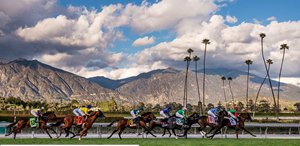Equine Fatalities in California Continue Steep Decline


Equine fatalities at California Horse Racing Board-regulated facilities dropped to 71 in 2021, the lowest tally in the state in 10 years of data posted on the CHRB website.
The tally represents a 26% drop from 2020 and nearly a 45% reduction from 2019 when a spike in deaths at Santa Anita Park in the early part of the year led to scrutiny and public outcry from anti-racing groups. According to Mike Marten, a CHRB spokesman, there was about a 9% dip in starts in California from the 2018-19 fiscal year to the fiscal year 2020-21.
California has implemented numerous equine health and safety measures since 2019, either by track regulations known as "house rules" or through CHRB regulation. Among the changes are medication restrictions, increased veterinary examinations and oversight, entry-review panels, and continuing education programs for trainers. The racing culture has also adapted to put equine safety more at the forefront.
"I think every stakeholder in California understands that animal welfare is the most important thing. It has to be because of the state in which we live and because it's the right thing to do," said Scott Chaney, executive director of the CHRB.
The CHRB tracks equine deaths in racing, training, and a category the regulator refers to as "other," in which horses that succumb to stable accidents or sickness are classified. Few regulators count all of those types of deaths.
Chaney said California's fatalities-per-start ratio is among the best in the country, if not placing it first, with the possible exception of a state with a preponderance of Standardbred racing, which is safer than Thoroughbred and Quarter Horse racing. Some racing regulators and tracks in other parts of the country do not publicize their fatality data.
He noted that 20 horses died last year in California in racing from more than 31,500 starts, a total that include races for Thoroughbreds, Quarter Horses, and Standardbreds.
Fatalities from racing, training, and "other" all dropped to their lowest levels in the CHRB data that goes back to 2012, when 238 horses died.
Last year 39 horses perished at CHRB facilities from musculoskeletal injuries and 32 from non-musculoskeletal conditions, including 2021 Kentucky Derby Presented by Woodford Reserve (G1) winner Medina Spirit , who collapsed and died after a workout Dec. 6 at Santa Anita. Chaney said that findings from a necropsy and toxicology reports into his death are expected within a month.
Golden Gate Fields led the state in fatalities last year with 26, ahead of Santa Anita with 21. The two tracks are open for training virtually year-round with a high volume of horses and run longer Thoroughbred meets than other such tracks in the state. Golden Gate ran over 1,100 races in 2021 with four racing fatalities. It also remained open for training during the fairs on the Northern California circuit.

Golden Gate had just one less fatality than it did in 2020, while other tracks had more significant reductions. Most of Golden Gate's equine deaths came not from racing but during training or were fatalities landing in the "other" category.
"I am hoping and I expect that will change somewhat given a regulation that just went into effect Jan. 1, and that is, private veterinarians will examine before they work as well, which is a new requirement for us," Chaney said. "So I think really focusing on training injuries is something we really need to pay attention to."
David Duggan, Golden Gate Fields general manager and vice president, characterized some of the "other" deaths as out-of-the-ordinary incidents.
Golden Gate, which had its Tapeta track installed in 2007, is the only remaining track in the state with a synthetic surface. Synthetic tracks are statistically safer than dirt, based on long-term data in The Jockey Club's Equine Injury Database, though, like dirt tracks, synthetic surfaces need maintenance and can degrade with time.
On March 4 of last year, anti-racing protestors disrupted racing Golden Gate by laying on the Golden Gate track surface, resulting in a cancellation of the day's first race and delaying six others by more than six hours. The protestors claimed the demonstration was in response to a high number of equine deaths at the track.
Golden Gate has three fatalities thus far in 2022, two from racing and one in the "other" category.
The North California racetrack came under criticism by the CHRB during last month's CHRB meeting after five equine deaths in November. Three of the CHRB's seven commissioners preferred to grant Golden Gate only a three-month license before a review. Ultimately, Golden Gate was given a standard six-month license.
The CHRB holds its monthly meeting Jan. 20, though Golden Gate is not a subject on the agenda. The CHRB meeting calls for an update from California Thoroughbred Trainers executive director Alan Balch, who heads an accident prevention task force in the state.
Balch declined comment Jan. 18 in advance of his upcoming remarks.
Methods to reduce shoulder injuries and sudden death episodes are likely to be topics addressed by the task force and the CHRB in the coming year.
